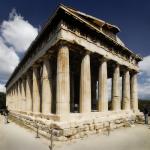|
This section contains 3,646 words (approx. 13 pages at 300 words per page) |

|
Idealism and Realism.
In modern society, photographic equipment makes it easy to capture images of one's self and one's family in portraits, and the ease with which such pictures can be created tends to devalue their significance. The absence of such technology in the Greek and Roman world, however, made the creation of portraits a very important and significant act that was generally done for a motive beyond the capturing of an image. In the sixth century B.C.E., victorious athletes in Greece were commemorated with portrait statues which presented an idealized picture of vigorous youth, though there was a degree of realism as well. Idealism was the hallmark of Greek portraiture because the motive of the portrait artist was not to portray an exact likeness—warts and all—but rather an impression of a real individual as an exemplar of vigor, intellectual power, or heroic virtue...
|
This section contains 3,646 words (approx. 13 pages at 300 words per page) |

|




